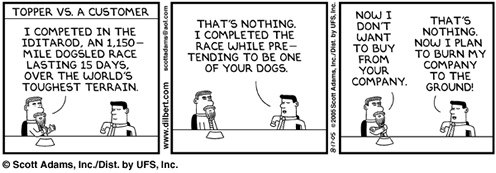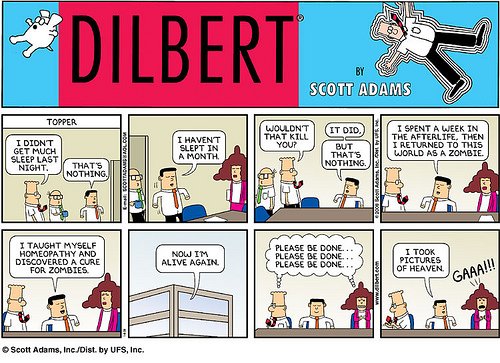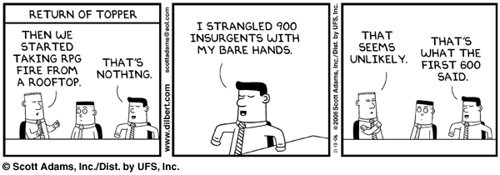Scott Adams’ perfect satire of workplace one-upmanship and the colleague we all recognize
The beginning of “The Topper” storyline by Scott Adams
In the pantheon of annoying office personalities that Scott Adams has immortalized in his Dilbert comic strip, “The Topper” stands out as particularly relatable. We’ve all encountered someone who simply cannot hear about your experience without immediately sharing how they’ve done something bigger, better, or more extreme.
This comic sequence brilliantly captures the escalating absurdity of workplace one-upmanship, where casual conversation becomes an Olympic sport of ego and exaggeration. As you read through the panels, notice how Adams masterfully builds the humor through escalation, taking the character trait to its logical (and ridiculous) conclusion.
Let’s enjoy one of Dilbert’s most spot-on office personality satires, panel by panel:
The Art of One-Upmanship

What makes “The Topper” so recognizable is the immediacy with which he turns any conversation into a competition. There’s no acknowledgment of the other person’s experience—just an automatic pivot to his own supposedly superior story.

As the sequence progresses, Adams takes the character trait to increasingly absurd extremes. The humor comes from watching the character’s desperate need to one-up his colleagues override any sense of plausibility or social awareness. The more outlandish his claims become, the more we recognize the fundamental insecurity that drives such behavior.
The Punchline: Taking It Too Far

What makes Adams’ workplace satire so effective is how it exaggerates real behavior just enough to highlight its absurdity without completely losing touch with reality. We laugh because we’ve sat across from “The Topper” at lunch—though perhaps a slightly less extreme version.

The Psychology Behind “The Topper”
While we laugh at “The Topper,” there’s actually some interesting psychology behind this common workplace behavior. One-upmanship typically stems from insecurity and a need for validation. By positioning themselves as having done something more impressive, the one-upper seeks to elevate their status in the group.
Unfortunately, this behavior usually backfires. Rather than earning respect, chronic one-uppers often find themselves alienated from colleagues who tire of having every conversation turned into a competition. The irony is that in seeking validation, they create the opposite effect—pushing away the very people whose approval they seek.
Scott Adams’ genius lies in his ability to capture these universal workplace dynamics and distill them into characters we instantly recognize. Through exaggeration and humor, he helps us see the absurdity in behaviors we might otherwise find merely annoying.
The Universal Appeal of Dilbert
Since its creation in 1989, Dilbert has remained relevant because it taps into the universal experiences of office life. Whether it’s dealing with incompetent management, navigating byzantine bureaucracy, or enduring colleagues like “The Topper,” Adams’ work continues to resonate with anyone who has worked in a corporate environment.
Characters like “The Topper” serve as humorous cautionary tales, allowing us to recognize and perhaps even check similar tendencies in ourselves. After all, while we laugh at the extreme version in the comic, most of us have occasionally fallen into the trap of one-upmanship in conversation without realizing it.
Join the Conversation
Have you encountered a “Topper” in your workplace? What other Dilbert characters have you recognized in your own office environment? Share your experiences in the comments below!

Laura says:
In defense of my topper-topperingness, mine are at least true! I have never killed any insurgents and have not been reincarnated as a zombie. =)
Ms Topper says:
I am guilty of Toppering. I cannot help being competitive. However, to topper all toppers, my name really is Topper.
Tim says:
I have a TOPPER in my office. today he told us the blizzard we are getting is not that bad, once he drove in a category 5 hurricane on the coast of Florida.
Ms Topper says:
A hurricane? That’s nothing. Once I drove through the desert at high speed in the dark with the lights off so that my passenger wouldn’t see how dangerous the road was and it would be over as fast as possible
Basement Cat says:
The desert in the dark? That’s nothing. I once drove straight down Olympus Mons backwards at 600 MPH in a rocket car with my hands tied behind my back while re-painting a perfect replica of the Mona Lisa with a brush in my teeth.
munki says:
Olympus Mons, backwards, rocket car, that’s nothing. I once skydived naked into a blast furnace on the event horizon of a blck hole, while detailing the east pediment of the elgin marbles, using a tiny chisle glued to one of my eyelashes.
Needless to say I didn’t use a parachute.
Jewel Reznicek says:
Just came to read about this, and I ended up spending 20 minutes reading your other stuff too, awesome work man
Alex says:
that’s nothing I was italian once…
Steve says:
That’s nothing; when I was advising god on the creation of the Universe I told him to create all of you Toppers (don’t all thank me at once). You provide normal people with an object of ridicule to vent their spleen on and thus contributes to a stable society. Despite the way you turned out I’m still glad I indirectly created you.
Mike says:
As I created the man you are now, Steve, I’m quite pleased with the way you turned out.
Topper says:
That’s nothing,
I ate three black holes for breakfast and plan on the universe for lunch with a little salt and pepper
www.podmod.de says:
Thats nothing. We repaired Chuck Norris iPhone (we repair iPhones).
Miguel Guerro says:
That’s nothing! I once made cube out of 6 black holes and then turned them inside out, creating the multiverse. But that’s nothing! Once I saw myself do that, I decided to create time and space to prevent anyone from knowing I did it.
youtwitface says:
That’s nothing! I repaired Chuck Norris’ Apple Watch while he was wearing it and while he was traveling through time to stop the creation of time and space.